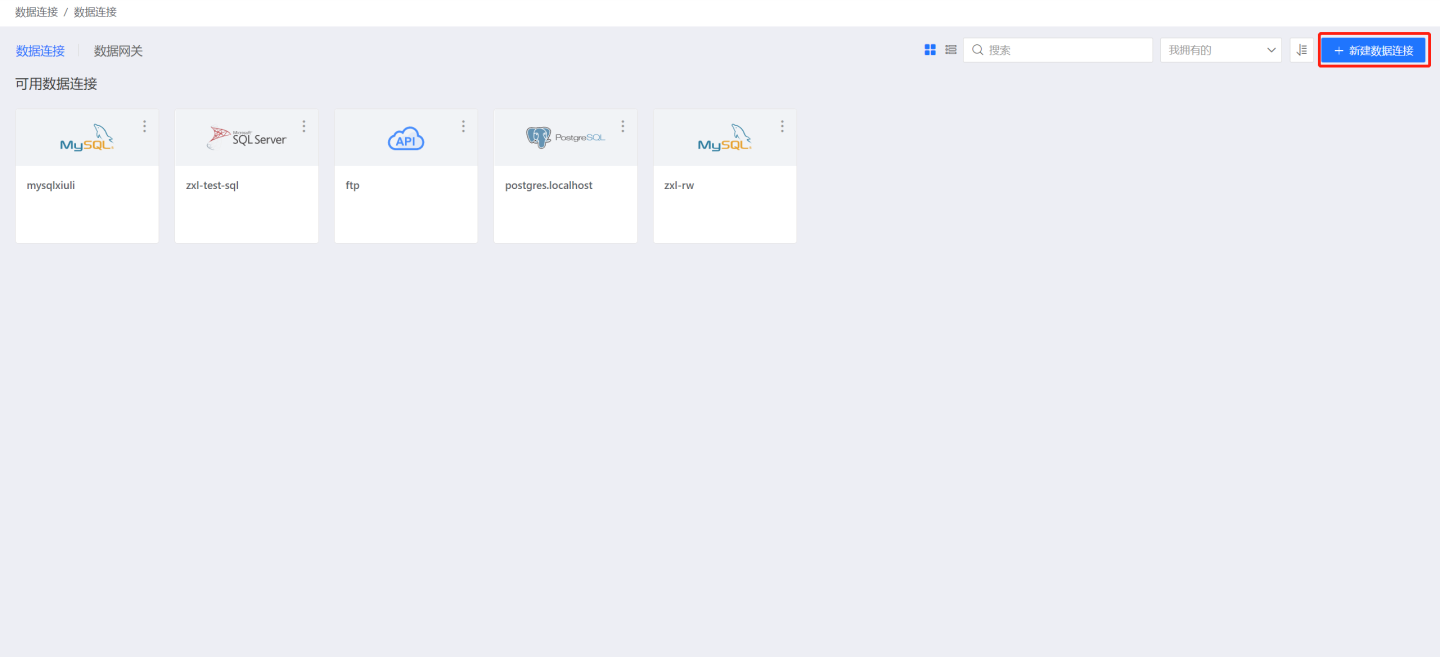Connect to MySQL
Please follow the steps below to connect to the MySQL data source.
- Click "New Data Connection" in the upper right corner of the Data Connection page.

- Select the MySQL data source from the data source types.

- Fill in the parameters of the data source as required when connecting.

- Name: The name of the connection, must be unique.
- Machine Address: The address of the database. If the url field is filled, the url will be prioritized.
- Port: The port of the database. If the url field is filled, the url will be prioritized.
- Username: The username of the database.
- Password: The password of the database.
- Database: The name of the database. If the url field is filled, the url will be prioritized.
- Maximum Connections: The maximum number of connections in the connection pool.
- Encoding: The encoding setting for the database connection.
- Prioritize Database Comment for Dataset Title: Whether to display the table name or the table comment first. Options include On and Off.
- Use Azure MySQL 8.0.15: Due to a bug in Azure MySQL 8.0.15 where the version number is incorrectly passed (for related instructions, refer to Limitations in Azure Database for MySQL), if you need to connect to this version of MySQL on Azure, please set this parameter to 'On'.
- Data Gateway: Whether the connection is made through a data gateway. If yes, fill in the gateway's ID.
- URL: The JDBC URL of the database.
- Transaction Isolation Level for Read Behavior: The transaction isolation level for read behavior. This setting only affects data reading, data writing still uses the default isolation level.
- Hierarchical Loading of Schema and Tables: When off, both schema and tables are loaded simultaneously. When on, schema and tables are loaded hierarchically, with only the schema being loaded during the connection process, allowing the data source to be quickly integrated into the system.
- Support Uploading Files to Specified Path: The specific path indicates the database name where files are uploaded. This parameter can only be configured after validation.
- Support Operations on Connected Database: Indicates that this connection can be selected as an output connection in Data Integration, Batch Sync, and Data Filling. Users must ensure they have write permissions for the database. This parameter can only be configured after validation.
- Show Tables Only Under Specified Database/Schema: When this option is selected and the database field is not empty, only tables under this database will be displayed.
After filling in the parameters, click the "Verify" button to obtain the verification result (verifying the connectivity between HENGSHI SENSE and the configured data connection; adding is not allowed if the verification is not passed).
After verification is passed,
Support Data Integration OutputandSupport Upload File to Specified Pathwill be enabled from disabled, allowing you to choose whether to enable these two options.Click to execute the preset code, and the preset code corresponding to the data source will pop up. Click the execute button.
Click the "Add" button to add the configured MySQL connection.
Please note
- Parameters marked with * are required, while others are optional.
- Window functions are not supported in MySQL versions 5 and below, so Advanced Calculations are not supported. The Acceleration Engine must be enabled to support them.
- Due to a bug in Azure MySQL 8.0.15 where the version number is incorrectly passed, if you need to connect to this version of MySQL on Azure, you need to specifically set the 'Use Azure MySQL' option.
- When connecting to a data source, the preset code must be executed. Failure to do so will result in certain functions being unavailable during data analysis. Additionally, when upgrading from versions prior to 4.4 to 4.4, the preset code needs to be executed for existing data connections in the system.